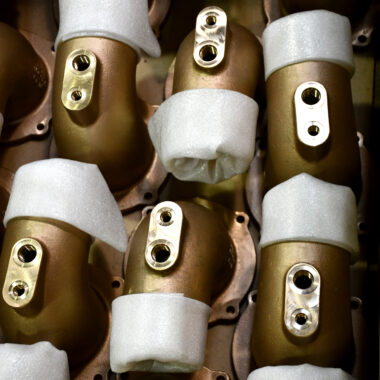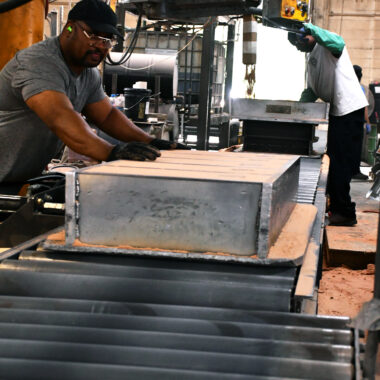Casting Aluminum 101: Essential Steps for Newbies
Casting Aluminum 101: Essential Steps for Newbies
Blog Article
Opening the Potential of Light Weight Aluminum Casting: A Comprehensive Introduction
Aluminum casting stands as a foundation in the world of metalworking, providing a plethora of benefits and applications across various industries. From its historical significance to the contemporary technologies in casting techniques, aluminum has constantly confirmed itself as a flexible and useful material. As we navigate via the landscape of aluminum spreading processes and look into the intricacies of quality assurance procedures, an extensive overview of opening truth capacity of this metal arises. The possibilities appear unlimited, promising insights that can revolutionize the method we utilize and perceive light weight aluminum in manufacturing (casting aluminum).

Background of Light Weight Aluminum Casting
Light weight aluminum casting has an abundant historical history that dates back to ancient worlds, showcasing the sustaining significance of this metallurgical procedure in different industries. The origins of aluminum spreading can be mapped to about 5,000 B.C. when old worlds like the Egyptians and the Sumerians utilized simple techniques to cast little things. However, it was not till the 19th century that aluminum spreading saw significant improvements with the discovery of the Hall-Héroult procedure for removing light weight aluminum from its ore, making it much more accessible for casting functions.
The versatility of light weight aluminum spreading allowed for detailed styles and intricate shapes to be produced with precision, additionally fueling its fostering across various fields. Today, light weight aluminum spreading proceeds to be a foundation in the production of a broad variety of items, highlighting its enduring legacy and value in contemporary production processes.
Benefits and Applications
With its outstanding strength-to-weight ratio and exceptional thermal conductivity, light weight aluminum spreading provides a myriad of advantages and varied applications throughout different industries. Among the primary benefits of light weight aluminum casting is its lightweight nature, making it an ideal option for sectors where weight decrease is essential, such as automobile and aerospace. casting aluminum. Furthermore, aluminum spreading offers excellent deterioration resistance, guaranteeing toughness and longevity in rough settings. Its high thermal conductivity additionally makes it a recommended choice for applications needing warmth dissipation, like in digital parts and warm exchangers.
In terms of applications, light weight aluminum casting is widely made use of in the auto industry for parts like engine blocks, cylinder heads, and wheels due to its toughness and lightweight homes. The flexibility of aluminum spreading extends to customer electronics, where it is utilized in the manufacturing of housings and heat sinks.
Types of Aluminum Casting Processes

Amongst the various approaches utilized in industrial setups, aluminum casting procedures include a series of techniques fit to different applications and demands. One of the most usual techniques is sand spreading, where a mold is developed by compacting sand around a pattern of the desired component. This procedure is affordable and versatile, making it popular for both small and large-scale production. Another commonly made use of technique is pass away casting, which involves requiring molten aluminum right into a mold dental caries under high pressure. Die casting permits high precision and repeatability, making it ideal for generating complicated shapes with thin wall surfaces. Financial investment spreading, likewise called lost-wax casting, is preferred for its capability to produce complex and thorough get rid of a smooth surface finish. Lastly, permanent mold spreading involves utilizing multiple-use steel mold and mildews to produce consistent and high-quality aluminum parts. Each of these aluminum casting processes uses unique benefits, satisfying a large range of commercial requirements.
Innovations in Light Weight Aluminum Spreading Methods
Recent advancements in aluminum spreading strategies have actually revolutionized the production market, supplying enhanced performance and precision in the manufacturing of complex components. One significant technology is the advancement of 3D sand printing technology, which makes it possible for the production of complex sand molds with minimal manual work. This method permits better design versatility and faster manufacturing cycles, making it ideal for prototyping and little batch production.
Additionally, making use of innovative simulation software application has substantially improved the casting procedure by enabling engineers to optimize mold and mildew layouts and anticipate prospective problems prior to manufacturing starts (casting aluminum). This causes boosted item top quality and reduced material waste
In addition, the fostering of vacuum-assisted aluminum casting has improved the overall high quality of castings by decreasing porosity and making sure a more consistent distribution of molten metal. This technique is particularly helpful for components that need high architectural honesty and exceptional surface finish.
Quality Control in Light Weight Aluminum Casting
The developments in aluminum spreading strategies have not only enhanced effectiveness and accuracy yet have actually additionally highlighted the important importance of quality assurance in making certain the dependability and performance of cast elements. Quality control in aluminum casting includes a systematic technique to recommended you read check and review the production procedure, determining any kind of inconsistencies from established requirements that might impact the last product.
One important aspect of top quality control is using advanced innovations such as non-destructive testing techniques like X-ray and ultrasound to spot interior defects without jeopardizing the honesty of the cast parts. Furthermore, implementing extensive examination procedures at various stages of manufacturing helps in determining and fixing issues immediately, making sure that just elements fulfilling the defined requirements are released for usage.
Furthermore, top quality control prolongs past the production process to include post-casting procedures like warmth therapy and surface completing, guaranteeing that the end products fulfill the preferred requirements. By prioritizing quality assurance procedures, manufacturers can enhance product uniformity, resilience, and general client satisfaction in the world of light weight aluminum spreading.
Verdict
Different types of casting procedures and cutting-edge techniques have been created to improve the performance and quality of light weight aluminum casting. Overall, light weight aluminum spreading continues anonymous to be an important manufacturing process with great possible for further developments in the future.
As we browse a fantastic read via the landscape of light weight aluminum casting processes and delve right into the details of quality control actions, an extensive review of opening the real potential of this steel arises. It was not till the 19th century that aluminum casting saw considerable advancements with the exploration of the Hall-Héroult procedure for extracting aluminum from its ore, making it extra obtainable for casting objectives.
Amongst the various techniques utilized in commercial settings, light weight aluminum casting processes include a variety of methods suited to different applications and needs. Investment spreading, likewise known as lost-wax casting, is favored for its capacity to produce comprehensive and intricate parts with a smooth surface area finish. Various kinds of casting processes and ingenious strategies have been developed to improve the performance and high quality of aluminum spreading.
Report this page